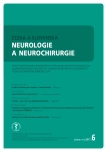Vascular Non-hemorrhagic Complications of Deep Brain Stimulation
Authors:
M. Kľoc 1; Z. Košutzká 2; J. Šteňo 1; P. Valkovič 2,3
Authors‘ workplace:
Neurochirurgická klinika LF UK
SZU a UNB, Nemocnica
akad. L. Dérera, Bratislava
1; II. neurologická klinika LF UK a UNB
Nemocnica akad. L. Dérera, Bratislava
2; Inštitút normálnej a patologickej
fyziológie, Slovenská akadémia vied
Bratislava
3
Published in:
Cesk Slov Neurol N 2017; 80(6): 690-694
Category:
Original Paper
doi:
https://doi.org/10.14735/amcsnn2017690
Overview
Background:
There are different complications described in deep brain stimulation. They are associated with electrode implantation, stimulation and hardware failure. Vasospasm and ischemic infarction around electrode are less often described complications. Objective: Analysis of group of patients with clinically significant vascular non-hemorrhagic complications intraoperatively or in the temporal context with deep brain stimulation electrode implantation.
Methods:
Retrospective analysis of 58 consecutive deep brain stimulation operations of subthalamic nucleus and globus pallidus internus from 2009 to 2016 with identification of the group of patients with vascular non- hemorrhagic complication. Risk factors for the development of these complications were analyzed.
Results:
We observed the case of patient with developement of subcortical ischaemia around electrode of deep brain stimulation and another four patients with acute onset of neurological symptoms such as central lesion of facial nerve, hemiparesis, transient somnolence and postoperative psychomotor passivity. Occurence of vascular non-hemorrhagic complications in the patient population was 8.6%.
Conclusion:
Vascular non-hemorrhagic complications in addition to their presentation in the form of ischemic infarction with correlate on postopreative imaging occur probably more frequently as perioperative transient accidents without correlate on postoperative imaging. Assumed mechanism of their developement is vasospasm.
Key words:
deep brain stimulation – surgical complication – vasospasm – ischemic infarction
The authors declare they have no potential conflicts of interest concerning drugs, products, or services used in the study.
The Editorial Board declares that the manuscript met the ICMJE “uniform requirements” for biomedical papers.
Chinese summary - 摘要
深部脑刺激的血管非出血性并发症背景:
深部脑刺激有不同的并发症。它们与电极植入,刺激和硬件故障有关。然而,血管痉挛和电极周围缺血性梗塞是较少描述的并发症。
目的:分析术中或在深部脑电刺激电极植入的临床上显著的血管非出血性并发症患者。
方法:
本研究回顾分析了2009年至2016年间连续58次丘脑底核和苍白球内部深部脑电刺激手术,并确定血管非出血性并发症患者组,并分析了发生这些并发症的危险因素。
结果:
观察深部脑刺激电极周围发生皮质下缺血的病例,以及另外4例神经系统症状(如面神经中枢损伤,轻偏瘫,短暂性嗜睡和术后精神运动的被动性)急性发作的患者。 患者中血管非出血性并发症的发生率为8.6%。
结论:
缺血性梗死形式的血管非出血性并发症以及术后影像学检查的相关性可能更多地发生在围手术期的短暂性事故,而术后影像学检查无相关性。其发展的假设机制是血管痉挛。
关键词:
深部脑刺激 - 手术并发症 - 血管痉挛 - 缺血性梗塞
Sources
1. Kleiner-Fisman G, Herzog J, Fisman DN et al. Subthalamic nucleus deep brain stimulation: summary and meta-analysis of outcomes. Mov Disord 2006;21(14):290– 304. doi: 10.1002/ mds.20962.
2. Soler EP, Ruiz VC. Epidemiology and risk factors of cerebral ischemia and ischemic heart diseases: similarities and differences. Curr Cardiol Rev 2010;6(3):138– 49. doi: 10.2174/ 157340310791658785.
3. Griffith RW, Humphrey DR. Long-term gliosis around chronically implanted platinum electrodes in the Rhesus macaque motor cortex. Neurosci Lett 2006; 406(1-2): 81– 6. doi: 10.1016/ j.neulet.2006.07.018.
4. Haberler C, Alesch F, Mazal PR, et al. No tissue dama-ge by chronic deep brain stimulation in Parkinson‘s disease. Ann Neurol 2000; 48: 372– 6. doi: 10.1002/ 1531-8249(200009)48:33.3.0.CO;2-0.
5. Lefaucheur R, Derrey S, Borden A, et al. Post-operative edema surrounding the electrode: an unusual complication of deep brain stimulation. Brain Stimul 2013;6(3):459– 60. doi: 10.1016/ j.brs.2012.05.012.
6. Sharma VD, Bona AR, Mantovani A. Cystic Lesions as a Rare Complication of Deep Brain Stimulation. Movement Disorders Clinical Practice 2015;3(1):87– 90. doi: 10.1002/ mdc3.12230.
7. Lim JY, De Salles AA, Bronstein J, et al. Delayed internal capsule infarctions following radiofrequency pallidotomy. Report of three cases. J Neurosurg 1997;87(6): 955– 60. doi: 10.3171/ JNS.1997.87.6.0955.
8. Novak KE, Nenonene EK, Bernstein LP, et al. Two cases of ischemia associated with subthalamic nucleus stimulator implantation for advanced Parkinson‘s disease. Mov Disord 2006;21(9):1477– 83. doi: 10.1002/ mds.20947.
9. Alford PW, Dabiri BE, Goss JA, et al. Blast-induced pheno-typic switching in cerebral vasospasm. Proc Natl Acad Sci USA 2011;108(31):12705– 10. doi: 10.1073/ pnas.1105860108.
10. Pluta RM. Delayed cerebral vasospasm and nitricoxide: review, new hypothesis, and proposed treatment. Pharmacol Ther 2005;105(1):23– 56. doi: 10.1016/ j.pharmthera.2004.10.002.
11. Claassen J, Bernardini GL, Kreiter K, et al. Effect of cisternal and ventricular blood on risk of delayed cerebral ischemia after subarachnoid hemorrhage: The Fisher Scale Revisited. Stroke 2001;32(9):2012– 20. doi: 10.1161/ hs0901.095677.
12. Goldsher D, Shreiber R, Shik V, et al. Role of multisection CT angiography in the evaluation of vertebrobasilar vasospasm in patients with subarachnoid hemorrhage. Am J Neuroradiol 2004; 25(9): 1493– 8. doi: 10.3174/ ajnr2004.25.9.1493– 8.
13. Hakim J. The penumbra: The therapeutic window. Neurology 1998;51(3):44– 6. doi: 10.1212/ wnl.51.3_Suppl_3.S44.
14. Weaver JP, Fisher M. Subarachnoid hemorrhage: an update of pathogenesis, diagnosis and management. J Neurol Sci 1994;125(2):119– 31. doi: 10.1016/ 0022-510X(94)90024-8.
15. Diehl RR. Cerebral autoregulation studies in clini-cal practice. Eur J Ulrasound 2002;16(1–2):31– 6. doi: 10.1016/ s0929.826600048.4.
16. Abulseoud OA, Kasasbeh A, Min HK, et al. Stimulation-induced transient nonmotor psychiatric symptoms following subthalamic deep brain stimulation in patients with Parkinson‘s disease: association with clinical outcomes and neuroanatomical correlates. Stereotact Funct Neurosurg 2016;94(2):65– 72. doi: 10.1159/ 000445076.
17. Christoforidis GA, Spickler EM, Papaioannou G, et al. Lacunar infarct during pallidotomy: case report. Neuroradiology 2001;43(4):321– 4. doi: 10.1007/ s002340000505.
18. Kang DW, Kim HY, Chang JW. Cerebral ischemia related to globus pallidus internus stimulation for cervical dystonia. Stereotact Funct Neurosurg 2011;89(4):201– 4. doi: 10.1159/ 000325655.
19. Downes AE, Pezeshkian P, Behnke E et al. Acute ischemic stroke during deep brain stimulation surgery of globus pallidus internus: report of 5 cases. Operative Neurosurgery 2016;12(4):383– 90. doi: 10.1227/ neu.0000000000001359.
Labels
Paediatric neurology Neurosurgery NeurologyArticle was published in
Czech and Slovak Neurology and Neurosurgery

2017 Issue 6
Most read in this issue
- Brief Test of Verbal Memory Using the Sentence in Alzheimer Disease
- State-of-the-Art MRI Techniques for Multiple Sclerosis
- H-reflex and Its Role in EMG Laboratory and Clinical Practice
- When to Operate on Temporal Bone Fractures?
